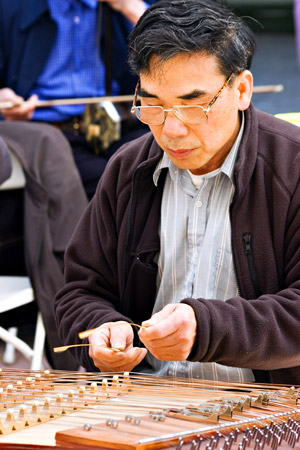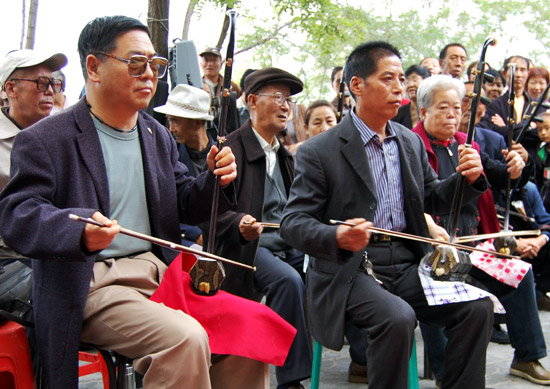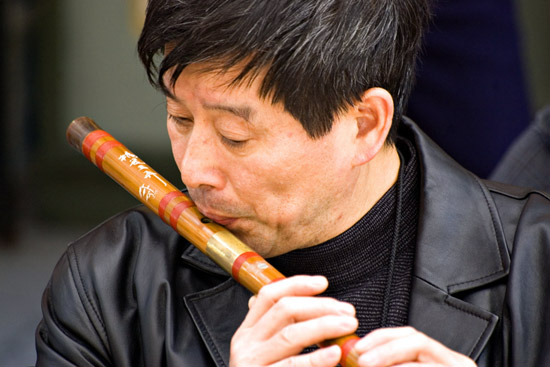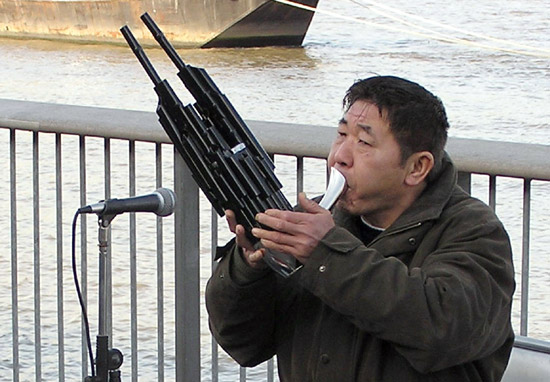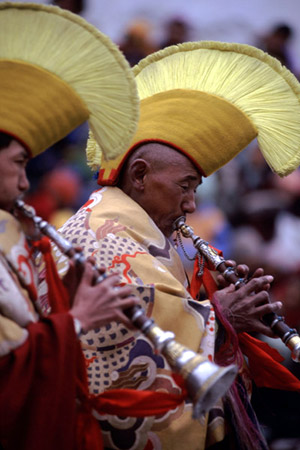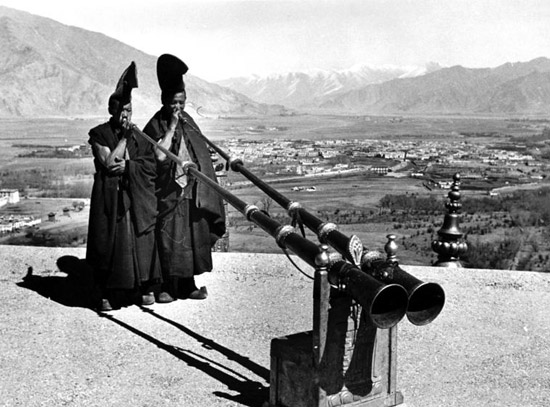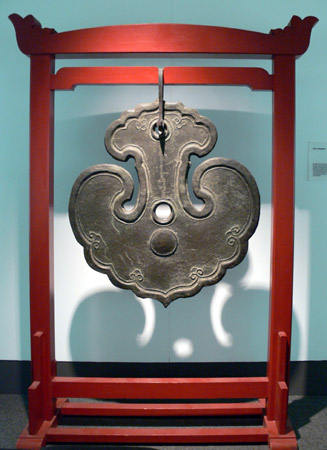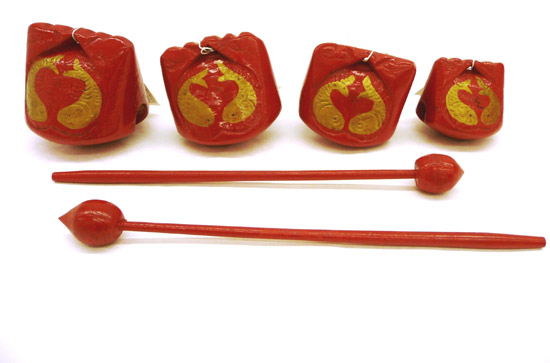Music: Instruments and Ensembles
Chordophones
Lutes: Pipa, Ruan, Yueqin, and Sanxian
These ancient instruments are all held vertically, played left-handed with plectrums or fingernails, and are capable of both solo and ensemble performances. The pear-shaped pipa and the round ruan (moon guitar) are four-stringed. The pipa has between 12 and 30 frets, and the ruan has 24 frets. The pipa has been around since the Qin dynasty, probably arriving in China from Central Asia or India. It became a favored court instrument under the Tangs; the royal court in Chang’an employed Persian and Kushan pipa players. There are two right-hand fingering techniques for the pipa, tantiao (forefinger and thumb) and lunzhi (all fingers). The ruan—named after Ruan Xian, a Jin Dynasty musician—has two sound holes, and comes in five types: xiaoruan (alto), daruan (bass), diyinruan (contrabass), gaoyinruan (soprano), and zhongruan (tenor).
The yueqin is similar to the ruan, except it has one soundhole, no bridge, amplifying metal coils inside, and comes in long-necked southern (used in Peking opera) and short-necked northern types. The long-necked, three-stringed, and fretless sanxian has a rectangular, snakeskin-covered resonator, and comes in small, medium, and large sizes. Less popular than the other three, it is not as often seen in opera or orchestral performances.
Zithers: Qin and Zheng
A favorite with the Confucian sages, the ancient qin (also known as guqin and qixianqin) is a delicate-toned, seven-stringed instrument. It originally had five twisted silk strings (symbolizing the five elements of earth, water, wood, metal, and fire), but two more were added during the Zhou dynasty; nylon strings are used now.
The curved soundboard symbolizes heaven and the flat bottom-board represents earth. The latter has two sound holes and two sound posts to connect it with the top plate and to prevent warping; the instrument is sensitive to temperature fluctuations and needs to be stored in an upright position. The strings pass over a yue shan (head bridge) and are secured by a long yin (end nut). Playing positions are indicated by 13 round hui (mother-of-pearl inlays), with the seventh hui (the halfway point, pitched an octave above the open string) being slightly larger than the rest; the number of hui represents the 12 months plus a leap month, and the overall qin measurements also correspond to 365 days.
The instrument is polished with a mix of powdered deer antler and lacquer. Over time, the laquer develops duanwen (cracks). These cracks are thought to improve the sound quality, are prized for their attractive look, and give an idea of instrumental antiquity; some modern instrument-makers produce artificial cracks to please (and sometimes mislead) their customers.
Players of the qin employ a range of techniques, arranged in three categories: plucking an open string produces san yin (scattered sounds); pressing a string lightly at a hui point while plucking with the other hand generates fan yin (floating sounds, or harmonics, an important component of qin sound and technique); pressing the strings to the soundboard, and then plucking and sliding, produces an yin (stopped sounds). Playing techniques also vary by region. Modern players can benefit from a variety of styles, and can participate in yajis (qin societies) to learn, perform, and socialize.
According to legend, a se master’s two daughters bickered over inheriting his 25-stringed zither and, to pacify them, he split it into two, creating the trapezoidal zheng in a 12-stringed version and a 13-stringed version. Modern zhengs have more than 25 strings, movable bridges, and a playing stand. The instrument is played by plucking and pressing with the fingers, or by using a plectrum, a bow, or a mallet.
Dulcimers: Yangqin
The yangqin, a trapezoidal hammered dulcimer of probably Persian origin, has 5 bridges and about 144 strings of varying thicknesses. It is played with a pair of rubber-tipped bamboo mallets; different mallets are used for different tones. The yangqin can be played solo and in ensemble.
Bowed Strings: Erhu, Erxian, Gaohu, Jinghu, and Banhu
Belonging to the huqin family of bowed string instruments, these instruments feature in Cantonese operas, and are versatile enough for other music genres as well. They are similarly constructed, each having two strings (formerly silk, now nylon or steel); a long, unfretted neck with two tuning pegs and a bent decorative end; a horsehair bow inserted through the strings; and a hexagonal (erhu), cylindrical (jinghu and gaohu), or rounded (banhu) soundbox that has a snakeskin membrane over the top and is left open at the bottom (that is, the back, when held vertically). The erhu is probably the best-known outside China; it is often referred to as the Chinese violin. The gaohu has a quiet sound, the jinghu is the only one made of bamboo, the banhu has a coconut-shell soundbox, and the erxian is not much seen outside of Cantonese music performances.
Tibetan Strings
The dramnyen is a long-necked, double-waisted, fretless lute carved from a single wood section. The snakeskin-covered resonator has a rosette of sound holes and is fitted with a floating bridge. The neck ends in a C-shaped pegbox with a carved, tassel-decorated chusing (sea monster). Of the seven gut or nylon strings, six terminate at the pegbox, while the seventh string attaches to a peg partway up the neck. The dramnyen is plucked or strummed with a plectrum, and used in the dramnyen cham dances. It is associated with Sharchop Gyalpo (Dhritarashtra of the Hindu epic Mahabharata) and depicted in thangka paintings.
Piwang, a one-stringed fretless spike fiddle, has a hollow body with a membrane-covered top and an open underside. It is made from bamboo or wood and played with a horsehair bow. The gyomang is a many-stringed hammered dulcimer used in opera music, and was traditionally played by Tibetan Muslim musicians.
Aerophones
Flutes: Xiao and Dizi
The end-blown, bamboo xiao flute has six to eight finger holes, a V-shaped or U-shaped chui kong (blowing hole), and metal tuning joints over and under the top and bottom finger holes. The side-blown dizi, also known as hengdi and di, is made from purple bamboo in Northern China and from white bamboo in Southern China. Dizi types include bangdi and qudi, and, in addition to the finger holes and blowing hole, there is a tissue-covered hole called mo kong; this gives the dizi a humming resonance.
Reeds: Suona, Guan, Bawu, and Mangtong
The conical suona and the cylindrical guan (bili) are double-reed instruments that developed, respectively, from the Central Asian surnay or zurna and the Zhou Dynasty hujjia. There are three suonas: zhongyin (alto), cizhongyin (tenor), and diyin (bass). There are two guans: the Cantonese honguan (small, medium, and large) and the Northern guanzi (alto and soprano).
The bawu free-reed flute, which developed in Yunnan, has six finger holes, one thumbhole, a closed upper end, a triangular free brass reed set sideways, and a bone mouthpiece. It is made from two bamboo sections that are joined together with a metal ring that can be adjusted for tuning.
The end-blown mangtong of the Miao and Dong people consists of a bamboo resonator fitted with a bamboo pipe containing a free metal reed inside. An ensemble of different-sized and different-pitched mangtongs is called lusheng.
Tibetan Reeds and Flutes
Used in Tibetan music, the gyaling consists of a conical wooden tube with a double-reed mouthpiece and a metal bell. The jogi baja is another double-reed instrument, similar to the Indian shenai, as is the surna, which is often played with the daman drum. The straight wooden flute, lingbu, is easier to play than the transverse bamboo flute thiling.
Free-Reed Aerophones: Sheng, Hulusi, and Hulusheng
The sheng, which evolved under the Zhou Dynasty, consists of 17 to 51 vertical and varied-length pipes that are fitted into a gourd or wooden base, the pipe arrangement resembling the decorative tail of the mythical Phoenix bird. Thin metal strips at the bottom of the pipes vibrate to produce a clear sound when the player blows through the base mouthpiece and manipulates the pipe keys or finger holes. The sheng is played solo or in ensemble with the suona and dizi, and often features in folk music and operas. This instrument is the predecessor of the accordion.
The hulusi (bilangdao) consists of three bamboo pipes—a finger-holed or keyed central one and two drones—inserted into a gourd wind chamber. The hulusheng is similar to the sheng, with five bamboo pipes protruding from the bottom of a gourd wind chamber and the narrow gourd neck serving as the mouthpiece.
Tibetan Horns
Tibetan music features the Indian-origin dungkar conch shell—in Hindu mythology, Lord Vishnu plays it. It has a deep, vibrating timbre that is matched in Tantric Buddhist rituals with the high tones of the kangling, a wind instrument (similarly played as a horn) made from a human femur—preferably from a criminal or victim of a violent death, as an act of compassion and of appeasement toward demonic spirits. The long—up to 15 feet (5 meters)—end-blown dungchen is made of collapsible metal (brass, copper, silver) sections, a conical bell, and a shallow mouthpiece. It has a very powerful, haunting sound, and is played in pairs at religious ceremonies and functions.
Idiophones
Gongs, Bells, and Cymbals
Different types and sizes of gongs—chau/tam-tam gongs and nipple (bossed) gongs, for example—are used for military signals, public announcements, dramatic and humorous moments in operas, and religious rituals and festivities. The yunluo or shimianluo (10-faced gongs), also known as cloud gongs, consist of 10 or 29 brass gongs fixed in a wooden frame that may be held in the hand or supported on a stand. The luo cymbals come in different sizes, and are played by clashing the two brass sections or by striking them with a stick. The lens-shaped, studded bianzhong bells are suspended on wooden frames, and played with a mallet, producing different tones when struck in different areas. The bianqing and fanxiang are similar, except the first are stone chimes and the second are metal rectangles.
Clappers, Rasps, and other Idiophones: Muyu, Paiban, Zhu, Yu, and Fou
The fish-shaped, hollow wooden muyu, often seen in Buddhist temples, is struck with a stick to keep time with religious chants and other activities. Paiban are hardwood or bamboo clappers, attached together with a cord, and held vertically. Zhu and Yu are hollow wooden instruments, the first a tapering box that is played with a stick, and the second a tiger with a serrated back that is played with a bamboo whisk. Fou—which featured in the 2008 Beijing Olympics—is a clay or metal pot that is played with a stick.
Tibetan Idiophones
Bubchal and puchen singchen are large metal cymbals used in Tibetan music for musical emphasis. The silnyen and rolmo cymbals are used in orchestral performances.
Used in Tibetan music, the nine-pronged dorje (lightning bolt) rattle and the drilbu handbell are used together in Vajrayana Buddhist rituals. They may be made of copper, bronze, or silver. The large metal khar nga gongs are played by striking.
Membranophones
Drums: Paigu and Guban
Paigu consists of different-sized, two-headed, barrel-shaped tanggu drums that are suspended from metal stands and played by two drummers in ensembles and orchestras. In the guban arrangement, a single person simultaneously plays the paiban clappers and a small bangu drum.
Drums: Dagu, Bangu, and Zhangu
The double-headed dagu drums come in two types, the high-pitched, narrow-based huapengu and the low-pitched, broad-based datanggu. The drums accompany wind and percussion instruments such as the small zhangu drums. The bangu is a small frame drum of hardwood that is secured on a stand and played with a bamboo stick.
Tibetan Drums
The large, double-faced, and vertically suspended nga ritual drum is played with a hooked drumstick to produce a deep, droning timbre to accompany cymbals and wind instruments. Damaru is a small, two-faced, hourglass-shaped drum with two attached hair balls; when the drum is shaken, the balls hit the drum membrane to produce a sound. There are two types of Tibetan damarus, one made from halves of two human skulls and the other from wood or ivory, with a red, white, and blue chopen (reality flag) usually attached to both versions; the skull damaru is used in Nyingma tradition, and the other schools use the wood/ivory one. The ritual drum, daman, is played to celebrate the birth of a child and for public announcements.
Article written for World Trade Press by Sonal Panse.
Copyright © 1993—2025 World Trade Press. All rights reserved.

 China
China 

